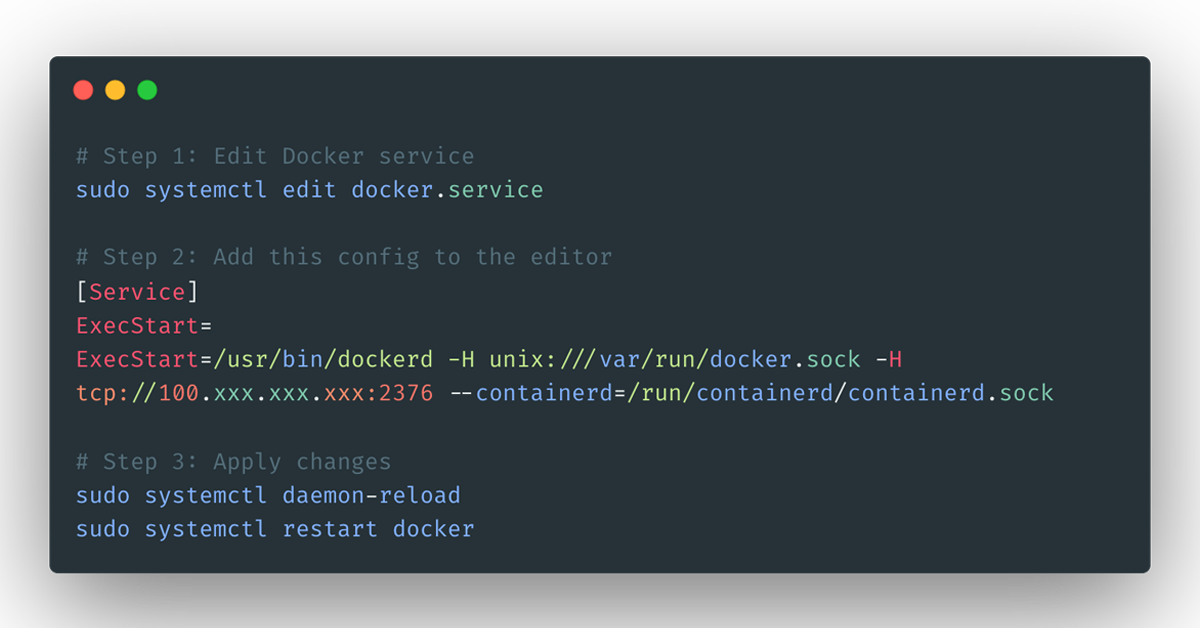Docker API Exposure via Tailscale VPN - Linux Setup Guide
Overview
This guide shows how to expose Docker’s API (port 2376) to your Tailscale VPN network on Linux systems. It’s a simple guide for those who want to use Docker remotely or access the status of Docker Containers from another device.
WARNING
We’re using port 2376 but without SSL/TLS encryption. Thus, you need to use a VPN tunnel to provide encryption and access control.

This is a workaround, but it's not a good idea to expose Docker API to the public internet.
Prerequisites
- Docker installed and running on Linux
- Tailscale VPN installed and connected
- sudo/root access to the system
Step 1: Find Your Tailscale IP Address
# Get your Tailscale IP
tailscale ip -4
Note the IP address (e.g., 100.xxx.xxx.xxx) - you’ll need this later.
Step 2: Configure Docker Daemon
Using systemd Override (Recommended)
# Create systemd override
sudo systemctl edit docker.service
Add this configuration (replace 100.xxx.xxx.xxx with your actual Tailscale IP):
[Service]
ExecStart=
ExecStart=/usr/bin/dockerd -H unix:///var/run/docker.sock -H tcp://100.xxx.xxx.xxx:2376 --containerd=/run/containerd/containerd.sock
Step 3: Apply Configuration
# Reload systemd and restart Docker
sudo systemctl daemon-reload
sudo systemctl restart docker
# Verify Docker is running
sudo systemctl status docker
Step 4: Configure Firewall
For UFW (Ubuntu/Debian):
# Install UFW if not present
sudo apt install ufw -y
# Allow SSH (important - don't lock yourself out!)
sudo ufw allow ssh
# Allow existing services
sudo ufw allow 80
sudo ufw allow 443
# Allow Docker API from Tailscale network
sudo ufw allow from 100.64.0.0/10 to any port 2376
# Enable UFW
sudo ufw enable
# Check status
sudo ufw status numbered
For iptables (Direct method):
# Add rule to allow Docker API from Tailscale network
sudo iptables -I INPUT -p tcp --dport 2376 -s 100.64.0.0/10 -j ACCEPT
# Save rules (method varies by distribution)
# Ubuntu/Debian:
sudo iptables-save > /etc/iptables/rules.v4
# CentOS/RHEL:
sudo service iptables save
Step 5: Verify Setup
# Check if Docker is listening on the correct port
sudo ss -tlnp | grep :2376
# Check your Tailscale IP
tailscale ip -4
# Test local connection
curl http://$(tailscale ip -4):2376/containers/json
Expected output should show JSON with container information.
Step 6: Test from Remote Device
From another device on your Tailscale network:
# Test Docker connection (replace with your Tailscale IP)
curl http://100.xxx.xxx.xxx:2376/containers/json
# Or test with Docker client
docker -H tcp://100.xxx.xxx.xxx:2376 ps
Security Notes
- ⚠️ Warning: This exposes Docker daemon without TLS encryption
- ✅ Safe: Tailscale provides encrypted VPN tunnel
- 🔒 Access: Only devices on your Tailscale network can connect
- 💡 Firewall: Uses Tailscale’s CGNAT range (100.64.0.0/10) for access control
- 🛡️ Best Practice: Consider using TLS certificates for production environments
Usage Examples
Once configured, you can use Docker remotely:
# Set environment variable for easier use (replace with your Tailscale IP)
export DOCKER_HOST=tcp://100.xxx.xxx.xxx:2376
# Now use Docker commands normally
docker ps
docker images
docker run hello-world
# Use with docker-compose remotely
docker-compose ps
docker-compose logs
Troubleshooting
Docker not listening on port 2376:
# Check Docker process
ps aux | grep dockerd
# Check systemd service
sudo systemctl cat docker.service | grep ExecStart
# View Docker logs
sudo journalctl -u docker.service -f
Connection refused from remote:
# Check firewall rules
sudo ufw status
# or
sudo iptables -L -n | grep 2376
# Test local connection first
curl http://localhost:2376/containers/json
Tailscale connectivity issues:
# Check Tailscale status
tailscale status
# Restart Tailscale
sudo systemctl restart tailscaled
# Re-authenticate if needed
sudo tailscale up
Docker service won’t start:
# Check for configuration conflicts
sudo journalctl -u docker.service --no-pager -l
# Temporarily remove custom config
sudo mv /etc/docker/daemon.json /etc/docker/daemon.json.backup
sudo systemctl restart docker
Enjoy Reading This Article?
Here are some more articles you might like to read next: